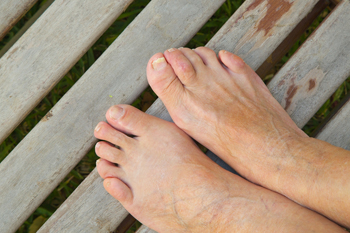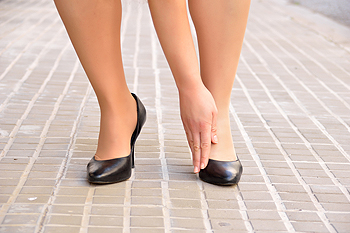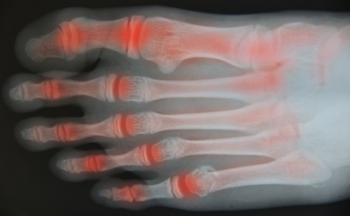 If you notice a sizable bump on the second toe of your foot, you may have what can develop into a hammertoe. Many people experience a bunion first, and this will typically occur on the side of the big toe. As this condition develops, the toes push against each other causing the middle toe to bend downward, and this may cause pain and discomfort. Research has shown this condition may be more apt to develop in people who are experiencing arthritis in the bones of the feet. There may be preventive measures to halt this ailment from happening, including wearing shoes that have adequate room for the toes to move about it in. Moderate relief may be found by performing specific exercises that can stretch the toes. One example would be to try soaking the feet in warm water daily, followed by pointing the toes. This may benefit in stretching the tendons of the toe. If you feel you are developing this condition, please consult with a podiatrist for treatment options that are correct for you.
If you notice a sizable bump on the second toe of your foot, you may have what can develop into a hammertoe. Many people experience a bunion first, and this will typically occur on the side of the big toe. As this condition develops, the toes push against each other causing the middle toe to bend downward, and this may cause pain and discomfort. Research has shown this condition may be more apt to develop in people who are experiencing arthritis in the bones of the feet. There may be preventive measures to halt this ailment from happening, including wearing shoes that have adequate room for the toes to move about it in. Moderate relief may be found by performing specific exercises that can stretch the toes. One example would be to try soaking the feet in warm water daily, followed by pointing the toes. This may benefit in stretching the tendons of the toe. If you feel you are developing this condition, please consult with a podiatrist for treatment options that are correct for you.
Hammertoes can be a painful condition to live with. For more information, contact Brent Harwood, DPM of Southeast Podiatry. Our doctor will answer any of your foot- and -related questions.
Hammertoe
Hammertoe is a foot deformity that occurs due to an imbalance in the muscles, tendons, or ligaments that normally hold the toe straight. It can be caused by the type of shoes you wear, your foot structure, trauma, and certain disease processes.
Symptoms
Risk Factors
Treatment
If you have hammertoe, you should change into a more comfortable shoe that provides enough room for your toes. Exercises such as picking up marbles may strengthen and stretch your toe muscles. Nevertheless, it is important to seek assistance from a podiatrist in order to determine the severity of your hammertoe and see which treatment option will work best for you.
If you have any questions, please feel free to contact one of our offices located in Fairhope, Brewton, and Atmore, AL . We offer the newest diagnostic and treatment technologies for all your foot care needs.
Read more about Hammertoe There are many women who enjoy wearing high heels despite knowing foot pain may develop from wearing these specific type of shoes. Research has shown that when the heel is high, the arch in the foot may become inflamed and this may typically cause pain and discomfort. If high heels are worn on a frequent basis, the toes may undergo stress, and this may possibly cause corns and calluses to develop. The likelihood of incurring a fall may increase as a result of the line of gravity being altered by the height of the heel. There are several ways to enjoy wearing high heels while keeping your feet as comfortable as possible. These may include slipping off your shoes at an appropriate time and performing gentle stretching exercises, including pointing, flexing and rolling your . Additionally, circulation in the feet may be increased by wiggling the toes. Your feet may benefit by wearing shoes that are more comfortable the following day, which may allow the foot muscles to rest. Please speak to a podiatrist if you would like additional information concerning the dangers of wearing high heels.
There are many women who enjoy wearing high heels despite knowing foot pain may develop from wearing these specific type of shoes. Research has shown that when the heel is high, the arch in the foot may become inflamed and this may typically cause pain and discomfort. If high heels are worn on a frequent basis, the toes may undergo stress, and this may possibly cause corns and calluses to develop. The likelihood of incurring a fall may increase as a result of the line of gravity being altered by the height of the heel. There are several ways to enjoy wearing high heels while keeping your feet as comfortable as possible. These may include slipping off your shoes at an appropriate time and performing gentle stretching exercises, including pointing, flexing and rolling your . Additionally, circulation in the feet may be increased by wiggling the toes. Your feet may benefit by wearing shoes that are more comfortable the following day, which may allow the foot muscles to rest. Please speak to a podiatrist if you would like additional information concerning the dangers of wearing high heels.
High heels have a history of causing foot problems. If you have any concerns about your feet or , contact Brent Harwood, DPM from Southeast Podiatry. Our doctor can provide the care you need to keep you pain-free and on your feet.
Effects of High Heels on the Feet
High heels are popular shoes among women because of their many styles and societal appeal. Despite this, high heels can still cause many health problems if worn too frequently.
Which Parts of My Body Will Be Affected by High Heels?
What Kinds of Foot Problems Can Develop from Wearing High Heels?
How Can I Still Wear High Heels and Maintain Foot Health?
If you want to wear high heeled shoes, make sure that you are not wearing them every day, as this will help prevent long term physical problems. Try wearing thicker heels as opposed to stilettos to distribute weight more evenly across the feet. Always make sure you are wearing the proper shoes for the right occasion, such as sneakers for exercising. If you walk to work, try carrying your heels with you and changing into them once you arrive at work. Adding inserts to your heels can help cushion your feet and absorb shock. Full foot inserts or metatarsal pads are available.
If you have any questions please feel free to contact one of our offices located in Fairhope, Brewton, and Atmore, AL . We offer the newest diagnostic and treatment technologies for all your foot care needs.
Read more about Effect of High Heels on the Feet The medical condition referred to as poor circulation is a result of restricted blood movement through the vessels. This generally occurs when the arteries are blocked, and the blood has difficulty flowing through the body. General causes for this condition to develop may include indulging in unhealthy lifestyle habits such as smoking, lack of exercise, or being overweight. Research has shown that medical conditions may play a significant role in developing poor circulation, including high blood pressure, having diabetes, or Raynaud’s syndrome. The latter condition will cause the feet to turn white while exposed to cold temperatures. There are known to be several symptoms associated with poor circulation, which may include cramping in the legs and feet, experiencing a tingling or numbing sensation, or having cold feet. If you have any of the above symptoms, it’s suggested to speak with a podiatrist, so a proper diagnosis can be performed.
The medical condition referred to as poor circulation is a result of restricted blood movement through the vessels. This generally occurs when the arteries are blocked, and the blood has difficulty flowing through the body. General causes for this condition to develop may include indulging in unhealthy lifestyle habits such as smoking, lack of exercise, or being overweight. Research has shown that medical conditions may play a significant role in developing poor circulation, including high blood pressure, having diabetes, or Raynaud’s syndrome. The latter condition will cause the feet to turn white while exposed to cold temperatures. There are known to be several symptoms associated with poor circulation, which may include cramping in the legs and feet, experiencing a tingling or numbing sensation, or having cold feet. If you have any of the above symptoms, it’s suggested to speak with a podiatrist, so a proper diagnosis can be performed.
While poor circulation itself isn’t a condition; it is a symptom of another underlying health condition you may have. If you have any concerns with poor circulation in your feet contact Brent Harwood, DPM of Southeast Podiatry. Our doctor will treat your foot care needs.
Poor Circulation in the Feet
Peripheral artery disease (PAD) can potentially lead to poor circulation in the lower extremities. PAD is a condition that causes the blood vessels and arteries to narrow. In a linked condition called atherosclerosis, the arteries stiffen up due to a buildup of plaque in the arteries and blood vessels. These two conditions can cause a decrease in the amount of blood that flows to your extremities, therefore resulting in pain.
Symptoms
Some of the most common symptoms of poor circulation are:
Treatment for poor circulation often depends on the underlying condition that causes it. Methods for treatment may include insulin for diabetes, special exercise programs, surgery for varicose veins, or compression socks for swollen legs.
As always, see a podiatrist as he or she will assist in finding a regimen that suits you. A podiatrist can also prescribe you any needed medication.
If you have any questions, please feel free to contact one of our offices located in Fairhope, Brewton, and Atmore, AL . We offer the newest diagnostic and treatment technologies for all your foot care needs.
Read more about Causes Symptoms and Treatment for Poor Circulation in the Feet One of the most common types of arthritis is referred to as rheumatoid arthritis. Many people may experience symptoms of this condition in the feet and are aware of the pain and discomfort that typically exists with this ailment. There are specific symptoms that may accompany this type of arthritis, including swelling and soreness in the feet, difficulty waking, which may be a result of unstable joints, or the foot possibly changing shape. Research has shown the part of the foot that may be affected the most are the toes, which consist of smaller joints. They may begin to look deformed and may have difficulty in moving or bending. There may be additional foot conditions that may arise including the development of corns and calluses. This may be a result of changes in the foot shape. If you are afflicted with rheumatoid arthritis, it is suggested to consult with a podiatrist who can offer proper treatment techniques.
One of the most common types of arthritis is referred to as rheumatoid arthritis. Many people may experience symptoms of this condition in the feet and are aware of the pain and discomfort that typically exists with this ailment. There are specific symptoms that may accompany this type of arthritis, including swelling and soreness in the feet, difficulty waking, which may be a result of unstable joints, or the foot possibly changing shape. Research has shown the part of the foot that may be affected the most are the toes, which consist of smaller joints. They may begin to look deformed and may have difficulty in moving or bending. There may be additional foot conditions that may arise including the development of corns and calluses. This may be a result of changes in the foot shape. If you are afflicted with rheumatoid arthritis, it is suggested to consult with a podiatrist who can offer proper treatment techniques.
Because RA affects more than just your joints, including the joints in your Feet, it is important to seek early diagnosis from your podiatrist if you feel like the pain in your feet might be caused by RA. For more information, contact Brent Harwood, DPM of Southeast Podiatry. Our doctor will assist you with all of your podiatric concerns.
What Is Rheumatoid Arthritis?
Rheumatoid Arthritis (RA) is an autoimmune disorder in which the body’s own immune system attacks the membranes surrounding the joints. Inflammation of the lining and eventually the destruction of the joint’s cartilage and bone occur, causing severe pain and immobility.
Rheumatoid Arthritis of the Feet
Although RA usually attacks multiple bones and joints throughout the entire body, almost 90 percent of cases result in pain in the foot area.
Symptoms
Diagnosis
Quick diagnosis of RA in the feet is important so that the podiatrist can treat the area effectively. Your doctor will ask you about your medical history, occupation, and lifestyle to determine the origin of the condition. Rheumatoid Factor tests help to determine if someone is affected by the disease.
If you have any questions please feel free to contact one of our offices located in Fairhope, Brewton, and Atmore, AL . We offer the newest diagnostic and treatment technologies for all your foot care needs.
Read more about Rheumatoid Arthritis in the Feet